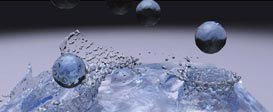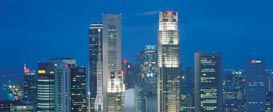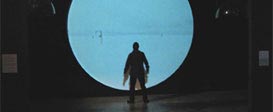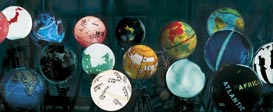Technical Papers
- The Technical Papers submission deadline was 28 May 2008.
- Frequently Asked Questions
- Detailed Instructions & Checklist
- Format Requirements
- Review Process
Other Questions About Submissions
Volunteering for the Technical Papers Program
1. I would like to submit my paper to conference X or journal Y as well as to SIGGRAPH Asia 2008.
You must submit to just SIGGRAPH Asia 2008 and await our response before submitting elsewhere (should your work not be accepted by SIGGRAPH Asia 2008). If you submit your paper to another conference or journal simultaneously, we will reject your paper without review. We'll be in contact with the editors of several graphics journals, and chairs of other graphics-related conferences, swapping information. Several double submissions to SIGGRAPH have been found in recent years.
2. I would like to submit my paper to conference X. Their submission deadline is after SIGGRAPH Asia 2008's jury meeting, but they require abstracts to be submitted before SIGGRAPH Asia 2008's jury meeting. May I submit the abstract?
Yes. The prohibition against dual submission kicks in when a full paper substantially equivalent to your SIGGRAPH Asia 2008 paper is submitted elsewhere. For conferences that require extended abstracts or other formats, you should ask the Papers Chair before submitting, to avoid risking your paper being rejected by SIGGRAPH Asia 2008.
3. But I want my paper to be in SIGGRAPH Asia 2008. I promise that if it's accepted by SIGGRAPH Asia 2008, I'll
withdraw it from the other conference or journal.
We appreciate your eagerness to have your paper published by SIGGRAPH Asia 2008. There is only one route to having this happen (see the previous paragraphs).
4. We've submitted a paper about a pilot study to conference X, and now we'd like to submit a paper about the full-blown user study to SIGGRAPH Asia 2008. How should we go about that to avoid the perception that it is a dual submission?
Cite the submitted paper in your SIGGRAPH Asia 2008 submission with a note to the reviewers that either it will be accepted by conference X, or you will publish it as a tech report and make it freely available on the web. Send in an anonymous version with your SIGGRAPH Asia 2008 submission. Then when you write the SIGGRAPH Asia 2008 paper, treat the pilot study as already published. Don't repeat text or figures from that paper in the SIGGRAPH Asia 2008 version.
5. I sent in a paper to workshop X with the understanding that it was for review purposes only, and the workshop would have no published proceedings. Now, four months later, they tell me that they're going to publish the proceedings and include it in the digital library. Unfortunately there is significant overlap between that paper and my submitted SIGGRAPH Asia 2008 paper. How should I handle this?
We realize that you didn't intend to do anything against the SIGGRAPH rules, but now that the workshop rules have changed, you should either withdraw the workshop paper from the proceedings or withdraw your SIGGRAPH Asia 2008 submission.
6. I am thinking about submitting a paper to SIGGRAPH Asia 2008, and I'm uncertain about the requirements.
Specifically: "Your paper cannot have been previously published in an equivalent or similar form. A paper is considered
published if it has appeared in a peer-reviewed journal or in published meeting proceedings that are commercially available afterward to non-attendees, regardless of the language of that publication." Does this include abstract-reviewed published meeting proceedings (for example, SPIE proceedings)? Does your restriction apply to papers accepted for journal publication?
If the meeting proceedings are published in a form that is visibly, reliably, and permanently available afterward in print or electronic format to non-attendees (as in the case of SPIE proceedings), then it is not appropriate to submit a paper that has been so published to SIGGRAPH Asia 2008. If your work has been accepted for journal publication (or even submitted), it is not appropriate for submission to SIGGRAPH Asia 2008. For more details, see Prior Art & Public Disclosure.
7. How do I reference an ACM SIGGRAPH Sketch on the same topic as the paper that I am writing?
Depending on the year of presentation, the Sketch might appear in the
ACM Digital Library. If it does, you should use the ACM
Digital Library as a reference. If it is not archived, you may refer
to the oral presentation at the conference or the abstract, if it appeared in one of the conference publications. If you were the author of the Sketch,
then citation is not strictly necessary because publication
of a Sketch does not preclude publication of a full paper.
If you were not the author of the Sketch, then you should cite the
Sketch to respect the author's ideas. If the authors have published
a subsequent paper, thesis, or tech report about their work, you should
cite that instead of the Sketch because it will be a more useful pointer
for your readers.
8. A month after submitting our paper, we obtained much better results. Can we withdraw our paper from review and submit it elsewhere (or wait until next year)?
SIGGRAPH Asia 2008 submissions can be withdrawn at any time. However, authors should remember that the programme chair and the senior reviewers on their paper know who they are, and may have already spent considerable effort reviewing their paper. Withdrawing a paper won't help your reputation with these reviewers.
9. How do I include a reference to myself without identifying myself?
The general rule is to use the third person. For example, if Fred Brooks were to write a paper, he might say in his "related work" section: "Brooks et al. [12] discuss a system in which molecular visualisations are ... Our work builds on some of the ideas presented there, and on the ideas of Smith et al. [14] and the interaction techniques described by Wolford [18]." He would NOT say: "The authors, in prior work [12], discussed a system in which molecular visualisation ... " The only case in which anonymous references are appropriate are unpublished manuscripts, in which case he might write: "The authors have also developed closely related techniques for molecular manipulation [15], but that work is outside the scope of this paper." Reference 15 would then read: [15] Anonymous Authors. Molecular manipulations through computer graphics, submitted to CACM.
If there is any danger that reference [15] might be considered a dual submission, then you should submit it as supplemental material with your SIGGRAPH submission, along with a cover letter (also submitted as supplemental material) briefly explaining the differences between it and your SIGGRAPH submission. You do not need to anonymise the cover letter, and normally you do not need to anonymise the supplemental manuscript either. However, if you believe it is important that all reviewers see that manuscript (for example, because it explains background concepts they might need in order to judge your SIGGRAPH Asia 2008 submission), then send in an anonymous version with your SIGGRAPH Asia 2008 submission. This will allow it to be sent to tertiary reviewers. Make sure your cover letter clearly identifies which PDF file is your SIGGRAPH Asia 2008 submission.
If you can submit these supplementary materials (and any cover letter) electronically, please do so. The submission form provides separate areas for submitting supplementary materials intended to go to all reviewers versus supplementary materials intended to go only to the primary and secondary reviewer. Non-anonymised materials that would identify you as the author, including any cover letter, should go in the second area.
10. My SIGGRAPH Asia 2008 submission needs to cite a technical report or thesis that might be hard for reviewers to find. What should I do?
You are welcome to submit that report or thesis as supplemental material. Cite it in the third person in your SIGGRAPH Asia 2008 submission, even if you are one of its authors. This avoids the necessity of anonymising it.
11. My SIGGRAPH Asia 2008 submission needs to cite one of our own web pages, which can't easily be anonymised. Now what should I do?
If you can reasonably cite the web page in the third person, go ahead. Remember, however, that reviewers may be reluctant to visit cited web pages, since doing so could compromise their anonymity. If for some reason you can't cite a web page in the third person, or if doing so would compromise your anonymity (for example, the same pictures appear in your submission and on the web page, or the web page includes a link to a paper by you that is cited in your SIGGRAPH submission as Anonymous Authors), then don't cite it; find another solution. If in this unusual case you're worried about a reviewer thinking that you've appropriated other people's work without proper citation, then submit as supplemental material a letter explaining the situation. You do not need to anonymise this letter.
12. My SIGGRAPH Asia 2008 submission needs to cite another, concurrent SIGGRAPH
submission by our group. Now what should I do?
Cite it as [16] Anonymous Authors, A grand unified theory of computer graphics, submitted to SIGGRAPH Asia 2008, and submit as supplemental material a letter telling us which paper_id you are referring to.
13. I know I am supposed to remove my name, company name, etc. from the document, but should I also remove names from the acknowledgements? If the paper is accepted, should I send another copy to you with this additional material?
You should not include an "acknowledgements" section in the submission. If your paper is accepted, you will submit a revised version that identifies you and your co-authors, your affiliations, and any acknowledgements that are appropriate.
Other Questions About Submissions
14. Where can I find a list of the Computing Reviews categories? Also, are we restricted to using keywords specified on the web site?
Yes, select one primary topic area and one or more secondary topic areas that best describe your paper. See ACM's Computing Classification System to determine the selection of keywords to describe your paper.
15. I have a problem with the video material I need to submit. My work involves manipulation of video, which has already been captured in PAL format. I can use a conversion service to go to NTSC, but this will negatively affect the quality of the video material. Would it be OK to submit the video as a QuickTime MPEG-4 movie on a CD-ROM or DVD-ROM, instead of as a VHS tape?
Yes.
16. The Detailed Instructions & Checklist page says pages should be numbered, but the document preparation instructions say that
page numbers should not be included. Which is correct?
You should number the pages. For the final version, if your paper is accepted, we'll ask that you not number the pages, but please number them for the submission. The sample documents in Document Preparation for Conference Proceedings all include page numbering.
17. The details in my imagery are very subtle: I am concerned that the reviewers will not print my paper on a suitable printer or view my video with an appropriate codec.
You still need to submit your paper as a PDF file, but you are welcome to use the physical submission process and send hard copy of the paper (in addition to submitting it electronically), or selected images, or of your video.
18. Does the video submitted by May have to be final quality? Or will people whose papers are accepted have the opportunity to prepare a more polished video?
You'll have the opportunity to prepare a more polished video. Of course, the better the submitted video looks, the more likely reviewers will be able to see the strength of your work, so early polishing is a good investment of time and energy.
19. Do we have to prepare the paper in the final format?
Yes, please do so. Seeing a paper in final format lets us verify the page count and allows us to compare it to other papers.
20. Hey, I know your REAL email address. Can I use that?
No, use the Technical Papers Email Contact Form, Why? First, I might be unavailable for several days. Second, during parts of the submission and review process, I will be buried in email. If you use the contact form, your email will go to the Technical Papers Chair, the Technical Papers Advisory Board, and selected administrators of the papers review process. One of them may be able to answer your question, and they will often do so surprisingly promptly.
If you have a question of extreme delicacy, or a question on which the Technical Papers Chair or a member of the Technical Papers Advisory Board might be conflicted, and only in this case, then you may use a real email address.
21. Can I submit after the deadline?
No. The deadline is absolute.
22. But I had a major life event (birth, death, divorce ...) just two days ago!
The deadline is absolute. You may, of course, submit the work in its current form by the deadline, even if it's not the paper that you'd like it to be.
23. But my fancy color printer stopped working at 4 pm, and the FedEx deadline is looming!
The deadline is absolute. Equipment failures are common, and SIGGRAPH Asia 2008 cannot adapt its schedule to accommodate them.
24. I was unable to upload my submission on time. The system was overloaded, and halfway through uploading my submission the deadline passed.
The deadline is absolute. Submissions that are in progress when the deadline passes, even if it's because our server has slowed down due to high load, will not be accepted. You should allow enough lead time to avoid this kind of problem.
25. I submitted a paper and six copies of a video. Unfortunately, in our rush to meet the deadline, we incorrectly set our gamma during taping, so we sent a fairly poor-quality video. I have since corrected the problem. May I substitute new videos for the ones I submitted? The video is identical, except for the gamma correction.
No. The submission deadline is absolute. All materials must be submitted by the deadline.
26. I'm using the SIGGRAPH Asia 2008 English Review Service, and they didn't get back to me soon enough, so it's SIGGRAPH Asia 2008's fault that my paper isn't ready. Can I submit late?
The deadline is absolute. The English Review Service makes no guarantees about turnaround, and it's up to you to make contingency plans.
27. I'm not in the US, and US Customs often holds up submissions, so I have to send my supplemental materials off two weeks earlier than US researchers would. Can I send it by the deadline instead, and you'll receive it about two weeks late, after US Customs has had a chance to process it?
The deadline is absolute. If your supplemental materials must pass through various hurdles to get here, you must plan in advance how to submit it early enough to ensure arrival on time.
28. I gave my supplemental materials to Federal Express, and I have a receipt to prove that they promised delivery before the deadline, but there was a snowstorm in San Francisco, and Federal Express couldn't meet their promise.
If you can provide the receipt (and we'll ask for it), then we'll accept the materials whenever Federal Express delivers them.
29. I am submitting a paper on topic X, which I know is an area of expertise for committee member Y. Can I ask that Y be a senior reviewer of my paper?
No.
30. I am submitting a paper on topic X, which I know is an area of expertise for committee member Y. Can I ask that Y not be a senior reviewer of my paper, because Y works for a competing company?
No. Indeed, Y may well be the best qualified reviewer for your work, and if so, we may ask Y to be the senior reviewer.
31. Am I allowed to ask for my paper to not be reviewed by someone from whom I do not expect a fair review?
No. The reviewer selection process includes no such provisions. Occasionally, during the committee meeting there is discussion such as: "This paper got scores of 5, 4, 5, 4.5, and 2, but let me explain the score of 2. The reviewer picked at small details, was angry that his own work had not been properly cited (although when I looked at it, it appeared to have been treated more than fairly), and then wrote a very cursory review of the main contribution of the paper. It seems as if there's something going on here that doesn't have to do with the quality of the paper and we should discount this score as an outlier."
32. Isn't the committee more likely to accept papers by committee members and other insiders? How do you prevent a conflict of
interest?
Any paper on which a committee member has a conflict of interest will not be discussed while that committee member is in the room. While each committee member has a list of papers and the committee members who reviewed them, these lists are customised so that the names of the members who reviewed papers on which I have a conflict of interest will not be shown on my list. In general, the acceptance rate for papers by committee members has been slightly higher than the acceptance rate for those in the overall submission pool. But the acceptance rate for these same people has also been higher in years when they were not on the committee; they're invited to be on the committee, in part, because of their expertise in the field.
33. I'm a SIGGRAPH reviewer, and I'd like to show this paper to one of my students, who frankly knows more about the topic of this paper than I do. May I?
Yes. You may show a paper under review to a small number of people, normally one or two, providing that you:
1. List their name(s), title(s) (e.g. "my PhD student"), and affiliation(s) in the private section of the review form, (question 9, which goes only to the papers committee).
2. Clearly instruct them on the rules of confidentiality of the SIGGRAPH review process.
However, it is not appropriate for others to write the review for you. If this is your intention, then you must discuss it with the senior reviewer who assigned you the paper. At their discretion, they may officially reassign the paper to your student. In this case, you lose a free mug, and the student gains one!
34. Reviewer #4 clearly didn't read my paper carefully enough. Either that or this reviewer doesn't know anything about the field!
How should I respond during the rebuttal period?
We've all received SIGGRAPH reviews that made us mad, particularly on first reading. The rebuttal period is short and doesn't allow for the
cooling-off period that authors have before they write a response to a journal review. As a result, authors need to be particularly careful to
address only factual errors or reviewer questions in the rebuttals rather than letting their emotions show through.
Please don't say: "If reviewer #4 had just taken the time to read my paper carefully, she would have realised that our algorithm was rotation invariant."
Instead say: "Unfortunately, Section #4 must not have been as clear as we had hoped because Reviewer #4 didn't understand that our algorithm was rotation invariant and he was therefore skeptical about the general applicability of our approach. Here is a revised version of the second paragraph in Section 4, which should clear up this confusion."
Remember that your rebuttal gets sent to all the reviewers; you don't want to offend them. In particular, you want the two senior reviewers to come out of the rebuttal process sufficiently enthused about your paper to champion it at the committee meeting, and if the paper is accepted and needs revision, then you want them to feel sufficiently comfortable with you as an author that they are willing to "shepherd" the paper through the revision process.
35. Now that I've read the reviews of my paper, I see much better how to organise it so it will be clear to the reader. Can I do
this reorganisation and upload the new version during the rebuttal period?
No. The rebuttal period is for addressing factual errors in the reviews, not for getting revised text into the review process. The committee
members will have only a short time in which to read and act on your rebuttal, and it must be short and to the point. Hence, it will be limited
to 2,000 words in the first place.
36. Between May and late July, we've gotten some really cool new results for our paper. Can I upload those results during
the rebuttal period? I'm sure that they will make the reviewers realise the importance of our approach.
No. The rebuttal period is for addressing factual errors in the reviews, not for getting new results into the review process.
37. Reviewer #2 says that our collision-detection algorithm won't work on concave objects. But it will, as we just demonstrated with the lid of the teapot. Can we upload a movie showing this new result?
No, not in the first round. Time is very precious at this stage in the review process, and you must keep your rebuttal short, or the reviewers and committee members will not have time to read it. If explicitly requested by a senior reviewer, please upload the additional video material.
38. I answered all reviewer criticisms during the rebuttal period, but no one responded, and now my paper is rejected. How can I be
sure the reviewers received and actually read my rebuttal?
The reviewers and committee members will have only a short time in which to read and act on your rebuttal. If additional information is not required, you may not receive a response to your comments. If you can view your rebuttal comments in the online review system, so can your reviewers. Rest assured that rebuttal information is considered and can be very helpful in the selection process.
39. Are papers merely published in print, or is there a presentation as well?
There is a presentation, of about 20 minutes length, followed by five minutes of discussion and questions. One of the authors of the paper must commit to making this presentation, in Singapore at SIGGRAPH Asia 2008, for the paper to be accepted. Also, in addition to the print format, the paper will be available in electronic format in the ACM Digital Library and as part of the conference DVD-ROM.
40. Where can I get the ACM Copyright Form on the web? I need to show it to my employers before I submit.
ACM Copyright Form (PDF)
41. My paper was just accepted to SIGGRAPH Asia 2008, and I'm thrilled. But now my boss points out that I can't use Mickey Mouse as the
example in my paper because I don't have the rights to use him. What do I do now?
The Call for Technical Papers explicitly stated that you must have permissions for all the images in your paper and the footage on your videotape, CD-ROM,
or DVD-ROM at the time of submission. You should immediately tell the Technical Papers Chair what you propose to use as a replacement. If the new images or
footage are not substantively similar to that submitted for review in the judgment of the Chair and the Technical Papers Advisory Board, then acceptance of
your paper will be rescinded. The archival record (Proceedings and DVD-ROM) must contain material that is equivalent to what the reviewers saw at
the time of review.
What follows is not "official" SIGGRAPH policy, but rather the impressions of former Papers Chairs, based on many years of service on the Papers Committee.
42. Is it important to submit a video with my paper?
There is a very strong correlation between submitting a video and getting accepted. An animation paper without a video is almost certain to be rejected.
43. Why are good papers rejected?
Check out this article by Jim Kajiya, the Papers Chair for SIGGRAPH 1993, for many excellent reasons. Although some of the details are dated, the general wisdom is timeless.
44. My paper was accepted with major revisions to a subsequent issue of ACM Transactions on Graphics. Does it have to appear there or can I submit it somewhere else?
SIGGRAPH Asia 2008 submissions can be withdrawn at any time. The offer to publish a revised version of the paper in an upcoming TOG issue is completely at the discretion of the author.
45. How do I decide whether to submit my work as a paper, a sketch, or a poster?
The Technical Papers programme is the most competitive of these three. Technical Papers also give you a chance to work out your ideas at greater length.
Finally, Technical Papers represent a citable archive, which are stored in the ACM Digital Library and elsewhere; beginning in 2008, SIGGRAPH Sketches
and Posters do not appear in the ACM Digital Library, and are therefore not citable as prior work by other papers.
If you believe your work is sufficiently mature to be a paper, then submit it to the Technical Papers programme.
46. How soon will my paper accepted with major revisions be published in ACM Transactions on Graphics?
The revisions will be verified by the original SIGGRAPH Asia 2008 reviewers, which greatly accelerates the refereeing process. Most should appear before SIGGRAPH Asia 2009.
47. My paper was accepted with major revisions to ACM Transactions on Graphics. Great, but I want to submit it to another
workshop, symposium, or conference first.
The offer to retain the original SIGGRAPH Asia 2008 reviewers evaporates the moment the paper is submitted anywhere else. The paper can always be submitted
to TOG later, but it will be reviewed through the ordinary refereeing process, which may, but probably will not, include any of the original SIGGRAPH Asia 2008 reviewers.
48. What about patents and confidentiality? Are the two senior reviewers and the three tertiary reviewers under a confidentiality
agreement not to disclose the contents of the paper to others? Some organisations like IEEE have all reviewers sign a confidentiality agreement. It's very important that I know for sure, since my employer may want to apply for a patent, and it affects when I may submit the paper to the SIGGRAPH Asia 2008 conference. Can I, for example, get a written guarantee of confidentiality?
Reviewers are asked to keep confidential all materials sent to them for review, but they do not sign a confidentiality agreement. In general, there is wide respect for the confidentiality of submissions, but we cannot promise anything, or provide a written guarantee.
It would not be wise for SIGGRAPH to give you legal counsel on the matter of patents and publication; we urge you to seek independent legal advice. The main issue is that in different jurisdictions (such as Europe) prior public disclosure could invalidate a patent application. The situation is different in North America, where you have one year after public disclosure (for example, publication) to file a patent. It is a common practice for authors to prepare a patent filing coincidentally with their SIGGRAPH publication.
49. When will my paper be publicly available?
Technical Papers accepted for presentation at SIGGRAPH Asia 2008 will be published in ACM Transactions on Graphics 27(5), a special fifth issue available in print and electronic format in early December 2008. Brief descriptions on accepted papers will be published on the SIGGRAPH Asia 2008 web site in September 2008.
Volunteering for the Technical Papers Programme
50. I've been doing graphics for years. May I be on the Papers Committee?
The Papers Chair selects the committee. I'll be selecting with several goals in mind, including: coverage of areas in which I anticipate submissions, getting some "old hands" who have been on the committee before, bringing some new folks into the process, recruiting people who will work well together and treat papers with respect and enthusiasm, and getting representation from diverse communities. If you'd like to participate, send email to the Technical Papers Chair and tell me about yourself and your areas of expertise.
51. I've volunteered to be on the committee for three years now, and I've never been chosen. What's up with that?
It may be that others are better qualified, that we already have committee members with expertise in your area, that the chairs do not feel that you've been in the field long enough to be an effective committee member, or any number of other reasons. The committee composition does change from year to year, though. Please keep offering your services.
52. Just what sort of workload is involved in being on the Papers Committee?
You must review about 20 papers. For about 10 papers, you must find two additional reviewers, and for the remaining papers you must find one additional reviewer. You must attend a Technical Papers Committee meeting, during which time, you'll discuss papers, possibly be called on to provide additional reviews of a couple of papers, and be expected to listen carefully to a lot of discussion that has little to do with you. Prior to the committee meeting you must participate actively in the rebuttal process, and then work with the other senior reviewers to come to consensus on recommendations for acceptance or rejection. You may also be asked to act as a referee for a paper that's been conditionally accepted or conditionally accepted with minor changes, to verify that the final version meets the requirements set for it. Finally, you may be asked to chair a papers session at SIGGRAPH Asia 2008.
53. What do I get for all the work that I'll be doing as a committee member?
In material terms, you get a deep discount when registering for SIGGRAPH Asia 2008, and you'll probably receive a t-shirt as well. You also receive the recognition of your colleagues, the gratitude of authors, and the sense of satisfaction that comes from knowing you've given something back to the organization that helps disseminate research in graphics.









